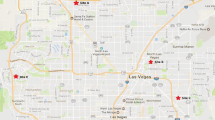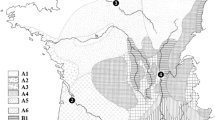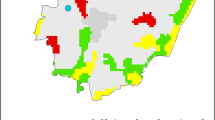Abstract
Cladosporium spp. is a ubiquitous mould present both in indoor and outdoor environments and affecting a wide array of substrates. It is considered to be the second most important fungal aeroallergen in countries of temperate climates, after Alternaria species. In order to establish the time of exposure to very high concentrations of Cladosporium conidia by sensitised individuals, a 5-year study was undertaken in the UK in a densely populated area using a volumetric air sampler. Weather data, comprised air temperature, precipitation, relative humidity and wind speed were collected simultaneously. Cladosporium showed a mono-modal pattern with the majority of conidia observed between 09:30 and 19:00 as indicated by descriptive statistics and multivariate regression tree analysis. On the other hand, circular statistics showed that the maximum hourly concentrations were found within 1.5-h window before 09:30. The highest conidia concentrations were observed when dry conditions occurred (40–55%). The maximum temperature associated with peak concentrations was oscillating within the range of 20–25 °C. All findings were confirmed using Kruskal–Wallis, Friedman and sign tests.



Similar content being viewed by others
References
Adams, K. F. (1964). Year to year variations in the fungus spore content of the atmosphere. Acta Allergologica, 19, 11–50.
Alves, C., Duarte, M., Ferreira, M., Alves, A., Almeida, A., & Cunha, Â. (2016). Air quality in a school with dampness and mould problems. Air Quality, Atmosphere and Health, 9, 107–115.
Bensch, K., Braun, U., Groenewald, J. Z., & Crous, P. W. (2012). The genus Cladosporium. Studies in Mycology, 72, 1–401.
Bousquet, P.-J., Hooper, R., Kogevinasw, M., Jarvis, D., & Burney, P. (2007). Number of allergens to be tested to assess allergenic sensitization in epidemiologic studies: results of the European Community Respiratory Health Survey I. Clinical and Experimental Allergy, 37, 780–787.
Bouziane, H., Latgé, J. P., Fitting, C., Mecheri, S., Lelong, M., & David, B. (2005). Comparison of the allergenic potency of spores and mycelium of Cladosporium. Allergologia et Immunopathologia, 33, 125–130.
Bräse, S., Encinas, A., Keck, J., & Nising, C. F. (2009). Chemistry and biology of mycotoxins and related fungal metabolites. Chemical Reviews, 109, 3903–3990.
Breitenbach, M., & Simon-Nobbe, B. (2002). The allergens of Cladosporium herbarum and Alternaria alternata. In M. Breitenbach, R. Crameri, & S. B. Lehrer (Eds.), Fungal allergy and pathogenicity (pp. 48–72). Basel: Krager.
Byung Uk, L. (2010). Effect of vibration on dispersal of Cladosporium cladosporioides bioaerosols. Journal of Microbiology and Biotechnology, 20(5), 904–907.
Calderón, C., Lacey, J., McCartney, A., & Rosas, I. (1997). Influence of urban climate distribution of airborne Deuteromycete spore concentrations in Mexico City. International Journal of Biometeorology, 40, 71–80.
Crous, P. W., Braun, U., Schubert, K., & Groenewald, J. Z. (2007). Delimiting Cladosporium from morphologically similar genera. Studies in Mycology, 58, 33–56.
D’Amato, G., & Spieksma, F. T. M. (1995). Aerobiologic and clinical aspects of mould allergy in Europe. Allergy, 50, 870–877.
Davies, R. R. (1959). Detachment of conidia by cloud droplets. Nature, 4676, 1695.
De’ath, G., & Fabricius, K. E. (2000). Classification and regression trees: A powerful and yet simple technique for ecological data analysis. Ecology, 81, 3178–3192.
Denning, D. W., Pashley, C., Hartl, D., Wardlaw, A., Godet, C., Del Giacco, S., et al. (2014). Fungal allergy in asthma–state of the art and research needs. Clin Transl Allergy, 4, 14.
Ellis, M. B. (1971). Dematiaceous Hyphomycetes. London: The Eastern Press Ltd.
Fernández, D., Valencia, R. M., Molnár, T., Vega, A., & Sagüés, E. (1998). Daily and seasonal variations of Alternaria and Cladosporium airborne spores in Leon (North-West, Spain). Aerobiologia, 14, 215–220.
Frankland, A. W., & Davies, R. R. (1965). Allergie aux spores de moisissures en Angleterre. Poumon Coeur, 21, 11–23.
Fromme, H., Gareis, M., Völkel, W., & Gottschalk, C. (2016). Overall internal exposure to mycotoxins and their occurrence in occupational and residential settings – An overview. International Journal of Hygiene and Environmental Health, 219, 143–165.
Fukutomi, Y., & Taniguchi, M. (2015). Sensitization to fungal allergens: Resolved and unresolved issues. Allergol Int, 64, 321–331.
Gravesen, S. (1979). Fungi as a cause of allergic diseases. Allergy, 34, 135–154.
Gregory, P. H., & Stedman, O. J. (1958). Spore dispersal in Ophiobolus graminis and other fungi of cereal foot rots. Trans Brit Mycol Soc, 41, 449.
Grinn-Gofroń, A., & Strzelczak, A. (2013). Changes in concentrations of Alternaria and Cladosporium spores during summer storms. International Journal of Biometeorology, 57, 759–768.
Hirst, J. (1952). An automatic volumetric spore trap. Ann Appl Biol, 39, 257–265.
Horner, W. E., Helbling, A., Salvaggio, J. E., & Lehrer, S. B. (1995). Fungal allergens. Clinical Microbiology Reviews, 8, 161–179.
Ianovici, N., Popescu, A., & Nemeş, C. (2008). Aeromycological monitoring of Cladosporium spores in Timişoara. Annals of West University of Timişoara, 11, 1–8.
Jäger, S. (2003). Plant taxonomy and nomenclature. Postęp Derm Alergol, 20, 218–226.
König, H., Unden, G., & Fröhlich, J. (Eds.). (2009). Biology of microorganisms on grapes, in must and in wine. Heidelberg: Springer.
Kurkela, T. (1997). The number of Cladosporium conidia in the air in different weather conditions. Grana, 36, 54–61.
Lacey, J. (1996). Spore dispersal – its role in ecology and disease: the British contribution to fungal aerobiology. Mycological Research, 100, 641–660.
Lacey, M. E., & West, J. (2006). The air spora. A manual for catching and identifying airborne biological particles. Dordrecht: Springer.
Mediavilla Molina, A., Angulo Romero, J., Infante García-Pantaleón, F., Comtois, P., & Domínguez Vilches, E. (1998). Preliminary statistical modeling of the presence of two conidial types of Cladosporium in the atmosphere of Córdoba, Spain. Aerobiologia, 14, 229–234.
Nilsson, S., & Persson, S. (1981). Tree pollen spectra in the Stockholm region (Sweden), 1973-1980. Grana, 20, 179–182.
Pady, S. M., Kramer, C. L., & Clary, R. (1969). Periodicity in spore release in Cladosporium. Mycologia, 61, 87–98.
Pasanen, A.-L., Pasanen, P., Jantunen, M. J., & Kalliokoski, P. (1991). Significance of air humidity and air velocity for fungal spore release into the air. Atmospheric Environment, 25A, 459–462.
Pashley, C. H., Fairs, A., Free, R. C., & Wardlaw, A. J. (2012). DNA analysis of outdoor air reveals a high degree of fungal diversity, temporal variability, and genera not seen by spore morphology. Fungal biol, 116, 214–224.
Peternel, R., Čulig, J., & Hrga, I. (2004). Atmospheric concentrations of Cladosporium spp. and Alternaria spp. spores in Zagreb (Croatia) and effects of some meteorological factors. AAEM, 11, 303–307.
Ranta, H., & Pessi, A.-M. (2006). Pollen Bulletin Summary 2005. Finnish Pollen Bulletin, 30, 1–12.
Rapiejko, P., Lipiec, A., Wojadas, A., & Jurkiewicz, D. (2004). Threshold pollen concentration necessary to evoke allergic symptoms. Internat. Rev. Allergol Clin Immunol, 10, 91–94.
Reponen, T., Willeke, K., Ulevicius, V., Reponen, A., & Grinshpun, S. A. (1996). Effect of relative humidity on the aerodynamic diameter and respiratory deposition of fungal spores. Atmospheric Environment, 30, 3967–3974.
Rich, S., & Waggoner, P. E. (1962). Atmospheric concentration of Cladosporium spores. Science, 137, 962–965.
Rodríguez-Rajo, F. J., Iglesias, I., & Jato, V. (2005). Variation assessment of airborne Alternaria and Cladosporium spores at different bioclimatical conditions. Mycological Research, 109, 497–507.
Sabariego, S., Díaz de la Guardia, C., & Alba, F. (2000). The effect of meteorological factors on the daily variation of airborne fungal spores in Granada (southern Spain). International Journal of Biometeorology, 44, 1–5.
Sadyś, M., Adams-Groom, B., Herbert, R. J., & Kennedy, R. (2016). Comparisons of fungal spore distributions using air sampling at Worcester, England (2006–2010). Aerobiologia, 32, 619–634.
Shaheen, I. (1992). Aeromycology of Amman area, Jordan. Grana, 31, 223–228.
Sindt, C., Besancenot, J.-P., & Thibaudon, M. (2016). Airborne Cladosporium fungal spores and climate change in France. Aerobiologia, 32, 53–68.
Stępalska, D., & Wołek, J. (2009). Intradiurnal periodicity of fungal spores concentrations (Alternaria, Botrytis, Cladosporium, Didymella, Ganoderma) in Cracow, Poland. Aerobiologia, 25, 333–340.
Troutt, C., & Levetin, E. (2001). Correlation of spring spore concentrations and meteorological conditions in Tulsa, Oklahoma. International Journal of Biometeorology, 45, 64–74.
Twaroch, T. E., Curin, M., Valenta, R., & Swoboda, I. (2015). Mold allergens in respiratory allergy: From structure to therapy. Allergy Asthma Immunol Res, 7, 205–220.
Weidenbörner, M. (2001). Encyclopedia of food mycotoxins. Heidelberg: Springer.
Zar, J. H. (1984). Biostatistical Analysis. New Jersey: Prentice Hall.
Zureik, M., Neukirch, C., Leynaert, B., Liard, R., Bousquet, J., & Neukirch, F. (2002). Sensitisation to airborne moulds and severity of asthma: cross sectional study from European Community respiratory health survey. BMJ, 235, 1–7.
Acknowledgements
This study was funded by the University of Worcester and conducted within the framework of the doctoral studies of the author. Special thanks go to two anonymous reviewers, Dr. Andrew M. Reynolds and Mr. Muralitharan Suppiah for the manuscript evaluation and valuable suggestions.
Author information
Authors and Affiliations
Corresponding author
Rights and permissions
About this article
Cite this article
Sadyś, M. An analysis of the exposure time to very high concentrations of Cladosporium conidia in the air of an urban site. Aerobiologia 33, 327–337 (2017). https://doi.org/10.1007/s10453-017-9472-8
Received:
Accepted:
Published:
Issue Date:
DOI: https://doi.org/10.1007/s10453-017-9472-8




